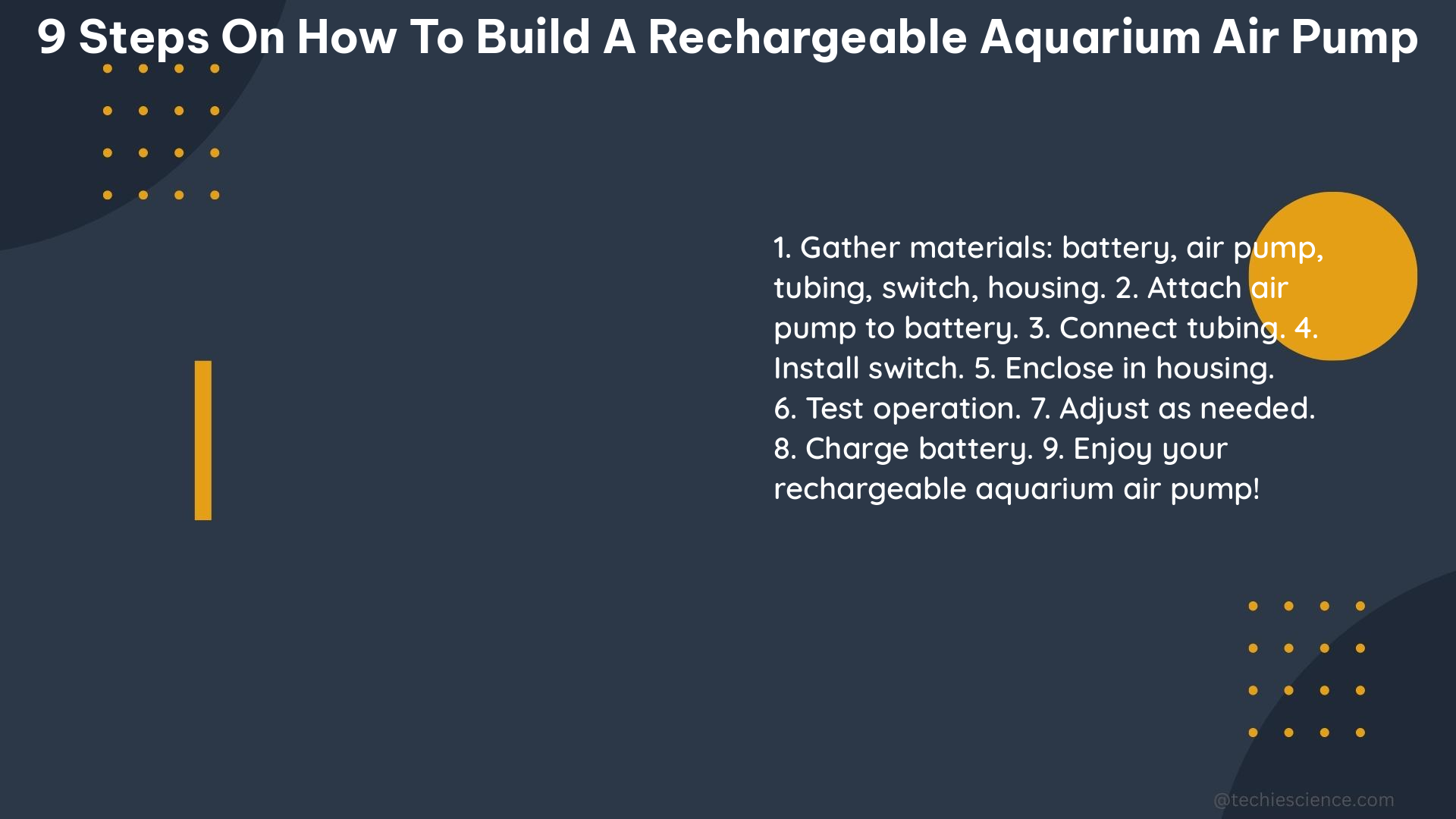Building a rechargeable aquarium air pump can be a cost-effective and customizable solution for maintaining a healthy underwater ecosystem. This comprehensive guide will walk you through the 9 steps to construct a reliable and efficient rechargeable air pump for your aquarium.
Step 1: Gather the Components
To build your rechargeable aquarium air pump, you’ll need the following components:
| Component | Quantity |
|---|---|
| LM2596 Buck (Step-Down) Converter | 1 |
| 5V Relay | 1 |
| TP4056 Charging Module with DW-01 Protector | 1 |
| Copper Dot Board | 1 |
| 18650 Rechargeable Battery (Li-Ion) | 1 |
| Terminal Connectors (Optional) | 2 |
| PCB Spacers (Optional) | 2 |
| Double-Sided Tape | 1 |
| Copper Wires | – |
| Diodes (1N4007) | 3 |
| Micro USB Cable | 1 |
| USB Charger | 1 |
| Battery Powered Air Pump | 1 |
The LM2596 buck converter is responsible for stepping down the voltage from the rechargeable battery to the required 5V for the air pump. The 5V relay is used to turn the pump on and off, with a coil voltage of 5V and a contact rating of 10A/250V AC or 10A/30V DC.
The TP4056 charging module with DW-01 protector ensures safe and efficient charging of the 18650 Li-Ion rechargeable battery, which has a nominal voltage of 3.7V and a capacity of typically 2000-3500mAh.
The diodes (1N4007) are used to prevent reverse current flow, with a voltage rating of 400V and a current rating of 1A.
Step 2: Building the Control Circuit

The control circuit is responsible for turning the air pump on and off. The 5V relay is the key component in this step, as it will be used to switch the pump’s power supply.
When the relay is energized, it will close the circuit, allowing the air pump to operate. When the relay is de-energized, it will open the circuit, turning the air pump off.
Step 3: Connecting the Rechargeable Battery
The 18650 Li-Ion rechargeable battery is the power source for your air pump. It has a nominal voltage of 3.7V and a capacity of typically 2000-3500mAh, providing several hours of operation depending on the air pump’s power consumption.
Step 4: Fixing the Issue
To prevent reverse current flow, you’ll need to install the 1N4007 diodes. These diodes have a voltage rating of 400V and a current rating of 1A, ensuring the protection of your circuit.
Step 5: Installing the Components to the Pump Casing
In this step, you’ll need to carefully arrange and secure the various components within the pump casing. This may involve using double-sided tape, PCB spacers, or other mounting methods to ensure a secure and organized layout.
Step 6: Turning ON the Pump
Once the components are installed, you can turn on the air pump and test its functionality. Ensure that the pump is operating as expected and that the control circuit is working correctly.
Step 7: Adding a Check Valve
To prevent water backflow and maintain the air pump’s efficiency, you should consider adding a check valve to the air line. This will allow air to flow in one direction while preventing water from entering the pump.
Step 8: Setting the Timer
Depending on your aquarium’s needs, you may want to incorporate a timer into your rechargeable air pump setup. This will allow you to schedule the pump’s operation, ensuring consistent aeration for your aquatic inhabitants.
Step 9: Testing the Air Pump
Finally, thoroughly test the rechargeable air pump to ensure it meets your aquarium’s requirements. Measure the flow rate, battery life, and overall performance to make any necessary adjustments or modifications.
Technical Specifications of a DIY Rechargeable Aquarium Air Pump
- Voltage: The system operates at a voltage range of 3.7V to 5V, depending on the battery level and input voltage.
- Current: The current draw depends on the air pump’s specifications and the flow rate required.
- Flow Rate: The flow rate can be adjusted by changing the air pump or by modifying the air stone and airline.
- Battery Capacity: The 18650 rechargeable battery typically has a capacity of 2000-3500mAh, providing several hours of operation depending on the air pump’s power consumption.
- Charging Time: The TP4056 charging module with DW-01 protector typically charges the 18650 battery in 3-5 hours, depending on the charger’s output current.
By following these 9 steps, you can build a reliable and customizable rechargeable aquarium air pump that will keep your underwater ecosystem thriving. Remember to always prioritize safety and consult additional resources if needed.
References:
- u/MindanaoStateUniversity – Is there a relatively inexpensive way to measure the airflow of an air pump?
- Automatic Air Pump (Rechargeable Auto Start) – YouTube
- Make an Emergency Battery Air Pump for Aquarium: DIY Hack – YouTube
- Group-3-DIY-Air-Pump (3) – CliffsNotes
